 previous article in this issue previous article in this issue | next article in this issue  |

Preview first page |
Document Details : Title: Lebēš pagrā' as the Language of «Incarnation» in the Demonstrations of Aphrahat the Persian Sage Author(s): SHCHURYK, Oleh Journal: Ephemerides Theologicae Lovanienses Volume: 83 Issue: 4 Date: 2007 Pages: 419-444 DOI: 10.2143/ETL.83.4.2025348 Abstract : One of the significant Christological themes elaborated by Aphrahat in his 23 Demonstrations is the mystery of Christ’s lebēš pagrā‘, namely, his ‘putting on a body’. The article focuses on the analysis of selected passages from the Demonstrations, which deal with this particular issue. After a brief overview of the Christological patterns used by Aphrahat in his Treatises, it focuses on the peculiarities of Aphrahat’s language, which does not depend on the Greek tradition. For example, when he talks about Christ’s ‘coming to the world’, this rather points to influence from early Syriac Christologies, such as: the ‘Acts of Thomas’ and ‘Odes of Solomon’. From the perspective of the “two-Adams” typology, the article approaches the soteriological dimension of Christ’s lebēš pagrā‘. Christ is the second Adam, who ‘puts on a body’. Christ’s incarnation, not only restores humankind to the glorious pre-fall status, which was lost by the first Adam, but also, as S. Brock explains, allows humankind to put on God and attain the status of divinity. This was the intention of God’s creation in the beginning. This interpretation cannot be fully appreciated without the crucial notion of keyānā’ which means ‘nature’, ‘reality’, ‘existence’. This term sheds more light on Aphrahat’s notion of Christ’s ‘putting on a body’. Furthermore, passages from the Demonstration’s, ‘Concerning the Cluster’, reveals that any docetic suspicions, with respect to Aphrahat’s doctrine of Christ’s lebēš pagrā‘, are unfounded. In conclusion, this article attempts to uncover the pedagogical aspects of Christ’s ‘dressing in the human body’. Christ, who not only puts on the corruptible and feeble body, but also elevates it to glory and honor, stands as the perfect model for the human being to follow in order to enter the divine realm. |
|


